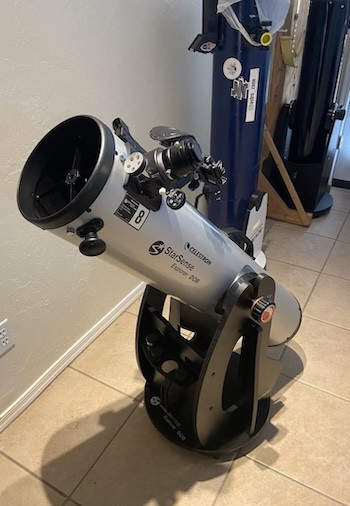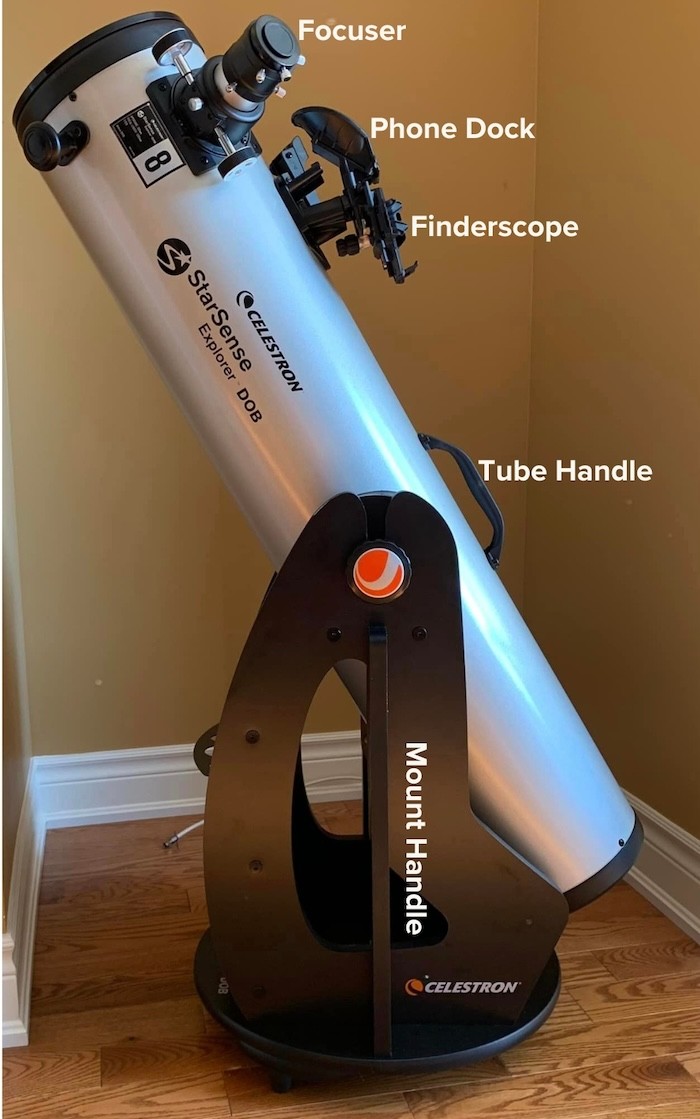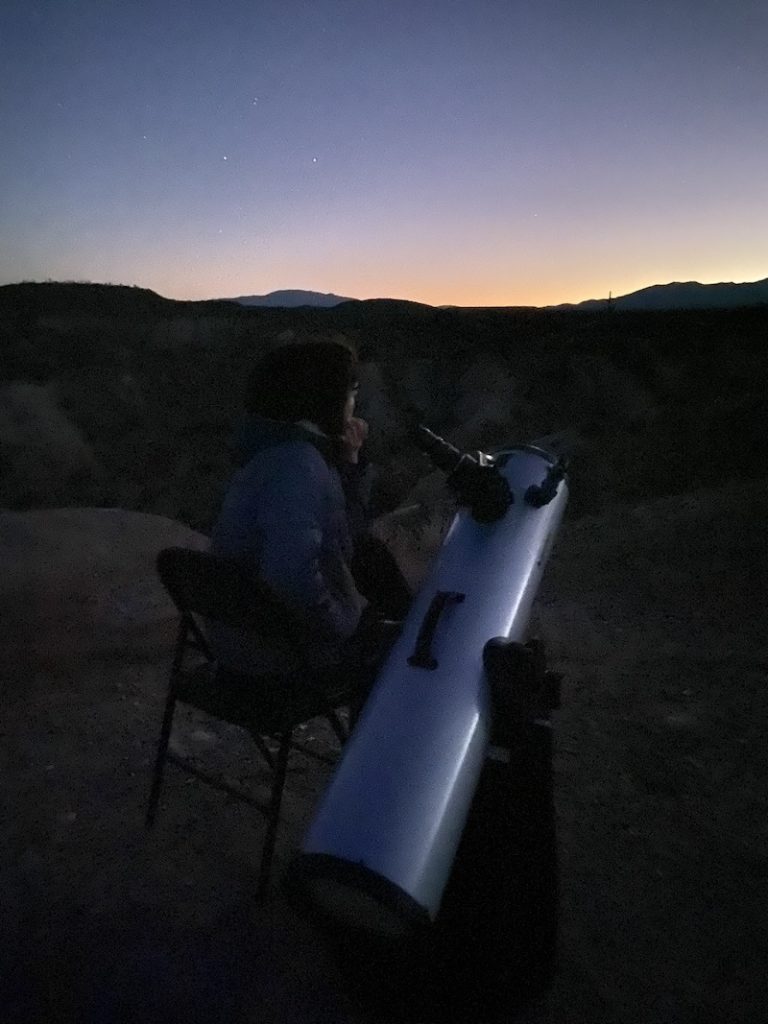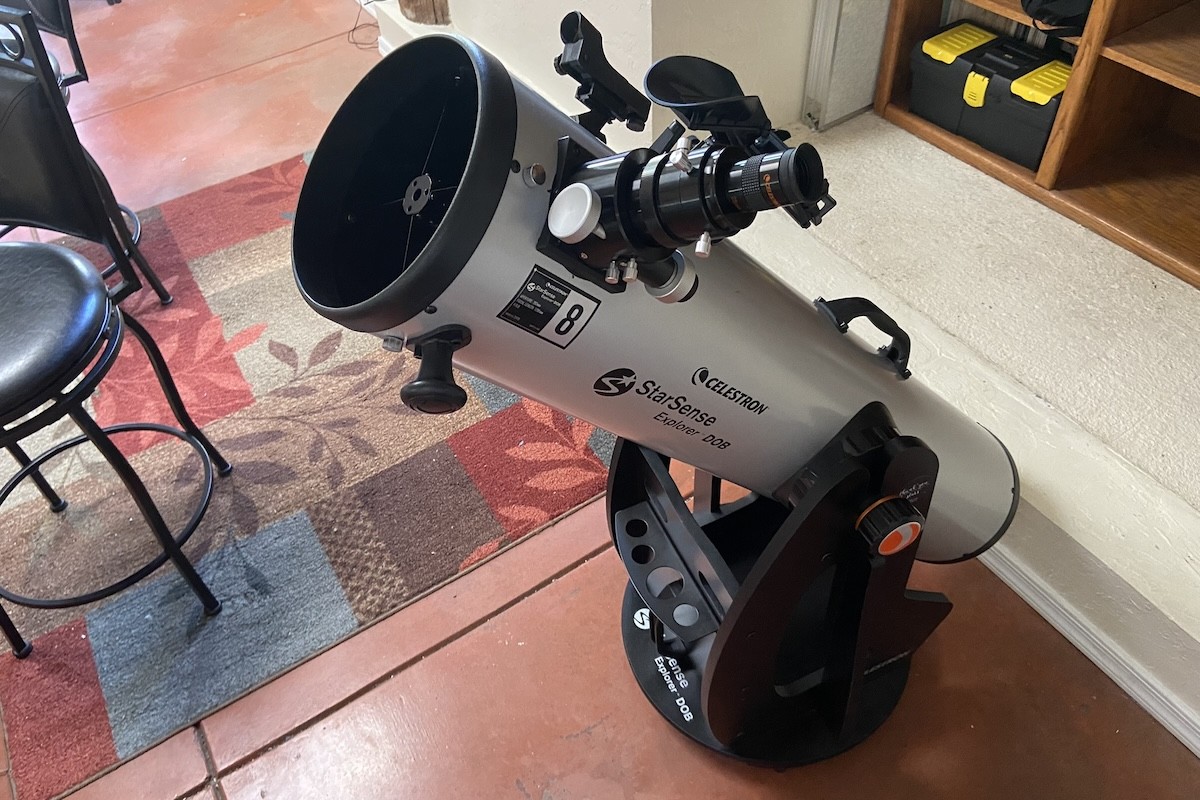

The Optical Tube
The StarSense Explorer 8” Dobsonian is optically an 8” (203mm) f/6 Newtonian reflector with a focal length of 1200mm. At f/6, there is little to no coma visible at the edges of the field of view at low magnifications, and I don’t really need extremely well-corrected wide-angle eyepieces to get sharp images with this scope.
The tube of the StarSense Explorer 8” Dob fits across the back of most vehicles and has built-in handles for both picking up the scope and aiming it in the sky, a nice bonus.
Buy StarSense 8″ Dob from Amazon- Collimation Mechanisms
Collimation of telescopes at f/6 is fairly easy. However, the StarSense Explorer 8” Dob requires that we use tools to adjust both primary and secondary mirrors.
The primary is collimated with a set of three easily-stripped Philips head screws, while the secondary mirror is adjusted with a hex key.
You shouldn’t need to adjust the primary mirror much, and the secondary mirror will likely never need to be adjusted after initially aligning it. But it’s still a major nuisance, especially when I’m on the observation field in total darkness and am trying to line up a screwdriver with the back of the scope without stripping the soft metal screw head.
- Focuser and Extension Tubes
The focuser on the StarSense Explorer 8” Dob is the same single-speed 2” Crayford focuser design that is provided with many Orion and Sky-Watcher Dobsonians that I’ve tested.
The supplied focuser uses thumbscrews to grip your eyepieces, and a 2” extension tube (included) is mandatory for reaching focus with most eyepieces. The included 1.25” adapter does, thankfully, include a compression ring and is threaded for 2” filters on the bottom for you to use 2″ filters with 1.25″ eyepieces if you ever want to. This Celestron scope doesn’t have the separate 1.25” and 2” extension tube shenanigans that plague Sky-Watcher’s Dobsonian lineup.
Accessories
The StarSense Explorer 8” Dob includes a single 25mm Plossl eyepiece providing 48x magnification.
The provided eyepiece is good to start with, but you’ll want more eyepieces at a variety of focal lengths for different magnifications. A high-power eyepiece for viewing the Moon and planets and a 2” wide-angle eyepiece for sweeping vistas of deep-sky objects are two examples of oculars you’ll probably need right away.
The only other accessory I got besides the required extension tube and 1.25” adapter is a standard red dot finder, which is used to aim the telescope by hand when I’m not using the StarSense Explorer app and phone dock.
The Dobsonian Mount
The Dobsonian mount that the StarSense Explorer 8″ Dobsonian uses has a lot in common with those from other manufacturers, particularly Sky-Watcher and some older Orion products made by the same OEM, Synta, Taiwan. Like all Dobsonians, it’s an alt-azimuth design that pivots up/down (in altitude) and left/right (in azimuth) on plastic pads, taking advantage of friction to provide smooth motion without any gears or locks.
The scope pivots on a pair of altitude bearings that glide on plastic rollers mounted inside the rocker box. The scope drops onto these bearings and has two brake/clutch knobs that slide into slots in the rocker on each side. These clutch knobs can be used to add friction to the scope’s movement up and down. It’s a slightly better version of the system Sky-Watcher uses on many of their Dobsonians.
However, as with many of the manual Sky-Watcher scopes, the StarSense Explorer Dobsonian’s clutch system is really just a stopgap measure to compensate for balance issues caused by using heavy eyepieces. The tube will otherwise droop when aimed lower in the sky. While technically a solution, tightening the clutch knobs, of course, impedes your ability to smoothly aim and track the telescope across the sky.
The StarSense Explorer Dobsonians use a base made out of particleboard and melamine, which you assemble yourself with a hex key.
RECOMMENDED BUY FOR THE WEIGHT OPTIMIZATION
In the optimized design of the base, this scope is unique. Rather than big, blocky pieces, the StarSense Explorer 8” Dobsonian’s base has cutouts designed for use as handles and uses the minimum possible amount of material to cut down on weight. The ground board is triangular instead of circular to save weight.
Buy StarSense 8″ Dob from AmazonThe StarSense Explorer App
I find using the StarSense Explorer app and phone dock to be extremely simple. After a quick alignment procedure, the app will help you locate thousands of deep-sky objects by showing you where your scope is pointed in the sky in real-time using your phone’s camera and gyroscope data.
Accuracy largely depends on the quality of your smartphone, but it can be as good as around ¼ of a degree, or half the width of the full Moon. Celestron has improved and updated the app for their Dobsonians, and it sports a far larger database than it used to. The previously tiny database made the StarSense Explorer technology essentially pointless for finding all but the brightest and most obvious targets, and I used to advise against those—not any more!
Should I buy a used Celestron StarSense Explorer 8” Dobsonian?
The StarSense Explorer 8” Dobsonian is a relatively new product, so it’s unlikely you’ll find a used one unless it was purchased and never taken outside. However, the usual advice applies: check for damage to the base or mirror coatings. Cosmetic damage or small dents in the tube are fine. A ruined base can be replaced, but doing so requires some carpentry or paying quite a bit for a custom one.
Alternative Recommendations
There aren’t other telescopes with directly comparable technology to the StarSense Explorer Dobsonians, and these scopes are near the top of our recommendations for their price range, but if you’re interested in something different, we have a few picks.
Under $600
- Fully Computerized Scope (Best): The Sky-Watcher Virtuoso GTi 150P has less aperture than the StarSense Explorer 8” Dobsonian but is extremely compact and has a fully motorized mount with GoTo technology, which can be controlled via your smartphone or aimed manually by hand. A 130mm model is also available.
$600-$800
- Manual Scope (Best): The Apertura AD8 is an excellent choice as it comes equipped with a dual-speed Crayford focuser, a built-in cooling fan, and plenty of first-class accessories such as a 2” wide-angle ocular and a 9×50 finder scope. They’re a better value for the price; however, they are a bit heavier and bulkier than the StarSense Explorer 8”.
- Manual Scope: The Explore Scientific 10″ Hybrid Dobsonian is more compact than the StarSense Explorer 8” and other solid-tubed Dobsonians but is more complex to assemble and severely lacking in accessories, though its 10” aperture does of course lead to greater performance at the eyepiece.
$800-$1200
- Manual Scope (Best): The Apertura AD10 incorporates the same great features of the 8” model such as its focuser and accessories, but with a larger aperture, albeit in a slightly heavier/bulkier form factor due to the similar dimensions of the base and tube.
- Partially Computerized Scope (Best): The Celestron StarSense Explorer 10” Dobsonian offers the same great features as the 8” model but with a larger aperture and easier collimation adjustments, despite being barely any heavier or bulkier and far lighter than most other 10” Dobsonian models.
- Computerized Scope: The Celestron NexStar 6SE is a little more compact and portable than a Dobsonian and offers a mount with GoTo & motorized tracking capabilities, though it lags behind any 8″ or 10″ Dobsonian in terms of performance as well as having a much narrower field of view than the Sky-Watcher Virtuoso GTi 150P, which boasts many similar features at a lower price.
Aftermarket Accessory Recommendations
At the minimum, since the StarSense Explorer 8” doesn’t come with more than one eyepiece, you’re going to want a few more of those. A 1.25” 6mm goldline eyepiece will provide 200x with the StarSense Explorer 8”, perfect for lunar and planetary views even on a night with moderately turbulent atmospheric conditions. You’ll be able to resolve globular star clusters with it too. A 1.25” 15mm SVBONY wide-angle eyepiece (80x) is a good choice for bridging the gap between the 25mm and 6mm eyepieces without breaking the bank. A wide-angle 2” eyepiece like the 38mm Apertura SWA (32x) is also a great choice, providing a huge field of over 2 degrees in the sky, but you’ll probably need to buy a magnetic barbell weight or something like it to compensate for the balance issues induced by some 2” eyepieces, especially if your targets are low in the sky.
The 1.25” to 2” adapter provided with the StarSense Explorer 8” has threads for 2” filters, so it’s worth future-proofing yourself by purchasing 2” filters even if you don’t get any 2” eyepieces right away. Many color and “moon” filters are essentially gimmicks, but the Orion UltraBlock is great for providing higher-contrast views of nebulae than you would otherwise get under almost any conditions. While not a cure-all “light pollution filter” (those don’t exist), the UltraBlock will help the StarSense Explorer 8” to provide jaw-dropping views of large emission nebulae like the Swan and Veil.
What can you see with the Celestron StarSense Explorer 8″?

The StarSense Explorer 8”, as with any good telescope with an aperture of 8”, is a powerhouse for viewing all kinds of objects. Even under light-polluted conditions, you can see a wide variety of open star clusters like M11 or M35, resolve individual stars in globular clusters like M13 and M15, split countless double stars, and, of course, view Solar System objects. The phases of Mercury and Venus are easy to see, and you’ll be able to resolve thousands of craters and mountain peaks on the Moon.
The StarSense Explorer 8” can show you a few dark markings on Mars along with its polar ice caps and any dust storms—careful observing techniques may also allow you to see its tiny outer moon Deimos. You’ll be able to see Jupiter’s cloud belts, the Great Red Spot, and its four large moons, which appear as tiny disks alongside their jet-black shadows whenever they transit in front of Jupiter and cause an eclipse over the planet’s cloud tops. Saturn’s rings are easy to see, along with the Cassini Division in the rings and a few cloud belts on Saturn. Up to 7 of Saturn’s moons can be seen under good conditions, though none are anything more than star-like pinpoints. Uranus is a turquoise disk; its 4 main moons are just at the limit of what you might be able to see with an 8” scope under dark skies. Neptune looks like a tiny blue dot, but its moon Triton is fairly conspicuous next to it, shining at magnitude 13. You might be able to see Pluto, but it’s fairly dim, even under dark skies, and it appears as nothing more than a star-like point.
The overall quality of any telescope’s views of deep-sky objects largely depends on your light pollution conditions; typical suburban light pollution (Bortle 5/SQM 20.5 or worse) will essentially wipe out galaxies altogether and significantly impair nebulae, while very light-polluted skies will make viewing everything but star clusters a frustrating task. Moderately dark (Bortle 4/SQM 21.2 or better) skies are needed for viewing galaxies and nebulae to their fullest extent with any telescope. The StarSense Explorer 8” will show you hundreds of colorful open star clusters and a few dozen globulars, most of which can be resolved into individual stars with a high-magnification eyepiece. Nebulae like Orion (M42) and the Lagoon (M8) are big and bright even under mediocre skies and are enhanced by a UHC filter; the Veil Nebula is spectacular under dark skies with a UHC or Oxygen-III filter, while a good UHC or H-Beta filter brings out the Horsehead and Flame Nebulae in Orion’s belt.
The Celestron StarSense Explorer 8” will easily show all of the galaxies in the Messier and Herschel 400 lists, and you can start to pick out features in brighter and more detailed galaxies. The spiral arms of M51 can be faintly glimpsed at medium magnification, while the dust lanes in M82, M64, and the gigantic Andromeda Galaxy (M31) are strikingly obvious even under light-polluted conditions thanks to their high contrast. Galaxy groups in Virgo, Coma Berenices, Ursa Major, Pegasus, and Fornax show dozens of members, some as far as a few hundred million light-years away—and if you’re going for a distance record, a few quasars—active black holes at the centers of galaxies billions of light-years away—can be seen as star-like points with an 8” telescope if you know where to find them.



